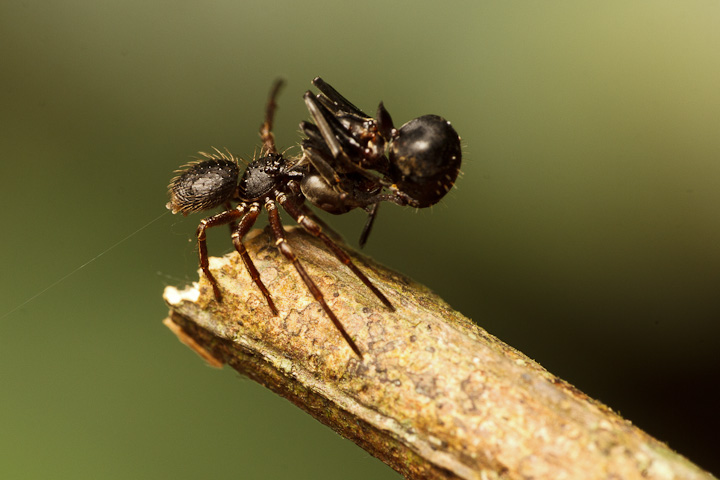Sean McCann recently returned from an epic journey through the rainforest of Guyana in search of caracaras, and is busy blogging about his adventures over at Ibycter.com (so you should check it out!). To make up for not taking me along, he found and photographed lots of awesome spiders for me to blog about. Here’s the first one!
Here we have a male crab spider (family Thomisidae) with its prey: an ant in the genus Dolichoderus*. At first glance, this may not seem particularly exciting. A small, hairy, black spider eats an insect. What’s so special about this scene?
Well, the spider appears to be Strophius nigricans, reported to be a specialist predator of ants. Most animals are not big on eating ants because they are generally distateful and well-defended by strong mandibles, stings, and defensive compounds. So specializing on ants is not particularly common, and tends to come along with some neat adaptations.
Strophius nigricans is not well studied, but I managed to find one paper about its predation behaviour. Oliveira and Sazima (1985) observed a male S. nigricans carrying an dead worker ant (Camponotus crassus) in the field in Brazil, and took it back to the laboratory to make some observations. The spider never let go of his ant carcass – this would come in handy later. In captivity, he was provided with some more C. crassus workers, and here his secrets were revealed.
The Strophius male used his ant corpse as a shield for protection against ants during predation. To eat ants, one must spend time near ants, but they don’t take kindly to intruders. The dead-ant-shield provides a clever disguise. Most ants don’t have especially good vision, and instead rely mainly on their senses of touch and smell. Whenever the Strophius male was approached by an ant, he would present his previous meal, which (obviously) feels just like another ant, and, if recently deceased, probably smells right too. As the spider pursued his prey, always attempting to sneak up from behind, he held the ant corpse aloft. Once within striking distance of an unsuspecting ant, he quickly dropped the shield and bit his new victim. Once dead, this new ant was used as a shield.

Unlike a related crab spider species that preys on ants, Aphantochilus rogersi (a remarkable ant-mimic), Strophius doesn’t look all that much like its victims. A. rogersi specializes on Cephalotes ants, which have relatively good vision, but its excellent mimicry is probably more important as a defense against visually hunting predators that avoid eating ants. However, a similar mode of defense is not necessarily out of the question for Strophius. The ants it preys on are black and have white hairs on the abdomen. From above, the spider carrying its ant-shield might look just enough like an ant carrying its comrade to fool a potential predator such as a bird.
As it turns out, the conclusion that Strophius nigricans are specialists on the ant species Camponotus crassus appears to be based on Oliveira and Sazima’s observations of the single male discussed above. Here we’ve seen that the spider also takes another species, and it seems that its prey capture technique should work just fine as long as the shield matches the subsequent target prey species. The visual mimicry would presumably be just as effective for any similar sized black ants. This certainly seems like a cool system that could use more investigation!

*Thanks Alex Wild for the ID!
References:
Oliveira, P. S., & Sazima, I. (1984). The adaptive bases of ant‐mimicry in a neotropical aphantochilid spider (Araneae: Aphantochilidae). Biological Journal of the Linnean Society, 22(2), 145-155. (pdf)
Oliveira, P. S., & Sazima, I. (1985). Ant-hunting behaviour in spiders with emphasis on Strophius nigricans (Thomisidae). Bulletin of the British Arachnological Society.

